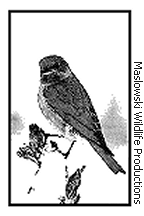
 | The eastern bluebird is a favorite migratory songbird of birders and nonbirders alike. The bird's bright blue color and melodious song make it a welcome visitor to backyards. The history of the bluebird spans a series of struggles and successes and only recently, through active wildlife management, has its future been considered secure. During the days of frontier settlement, the bluebird was among the wildlife species that benefited from the decimation of the eastern forests. The conversion of forest into pasture, orchards, and homesites created an abundance of ideal bluebird habitat - open areas that supported the nesting and foraging activities of the species. Farmers unintentionally assisted bluebirds by bordering their fields with wooden fence posts, thus supplying additional nesting sites. Combined, these factors led to a proliferation of bluebird numbers throughout the eastern United States through the mid-1800s. However, this situation changed in the late nineteenth century with the introduction of the European starling and the English house sparrow. In the twentieth century, increased use of harmful pesticides, replacement of wooden fence posts with |
This pamphlet is designed to serve as an introduction to the habitat requirements of the eastern bluebird and to assist in the development of a comprehensive bluebird management plan. The success of any individual species management plan depends on targeting the specific needs of the species and analyzing the designated habitat areas as a whole to ensure that all required habitat elements are present. This guide also provides recommendations for program monitoring to document successes and to ensure that problems are addressed as they arise.
Anonymous. 1999. Eastern Bluebird (Sialia sialis). U.S. Department of
Agriculture, Natural Resources Conservation Service, Madison, MS, and
Wildlife Habitat Council, Silver Spring, MD. Fish and Wildlife Habitat
Management Leaflet No. 2. 12 pages.
This resource should be cited as:
Anonymous. 1999. Eastern Bluebird (Sialia sialis). U.S. Department of
Agriculture, Natural Resources Conservation Service, Madison, MS, and
Wildlife Habitat Council, Silver Spring, MD. Fish and Wildlife Habitat
Management Leaflet No. 2. 12 pages. Jamestown, ND: Northern Prairie
Wildlife Research Center Online.
http://www.npwrc.usgs.gov/resource/1999/eastblue/eastblue.htm (Version 16AUG99).
 eastblue.zip (150K bytes) -- Eastern Bluebird (Sialia sialis)
eastblue.zip (150K bytes) -- Eastern Bluebird (Sialia sialis)
|
U.S. Department of the Interior,
U.S. Geological Survey 8711 37th Street SE, Jamestown, North Dakota 58401, USA URL: http://www.npwrc.usgs.gov Contact: npwrc@usgs.gov Site Last Updated: October 14, 2004 Privacy Statement | Disclaimer | FOIA | Accessibility |

|